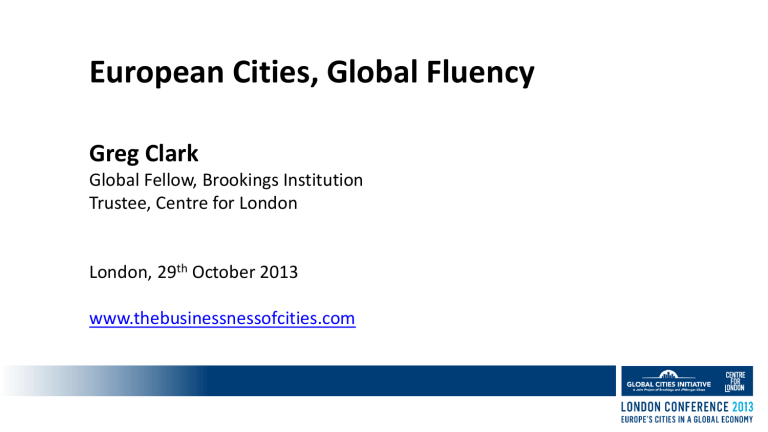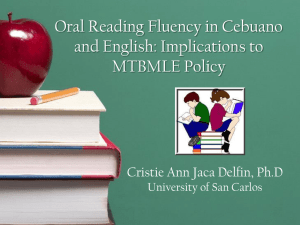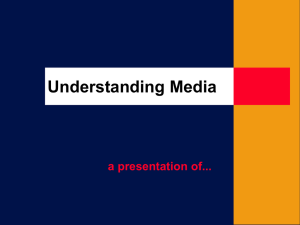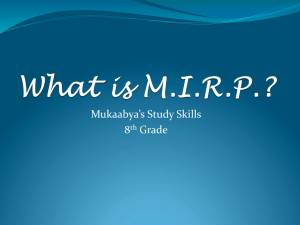Greg Clark - Centre for London

European Cities, Global Fluency
Greg Clark
Global Fellow, Brookings Institution
Trustee, Centre for London
London, 29 th October 2013 www.thebusinessnessofcities.com
Europe’s cities: how have we got here?
The Return of the Blue Banana?
Unique history of international trade and exchange.
1945-1973, Western European trading and labour integration.
• Amsterdam-Milan-Paris triangle
1973-1991, post oil-crisis adjustment
• services; London and Paris move ahead
1992 Single EU Market
• More competition in enlarged city system
Today, 80 European metropolitan areas > 500,000.
Europe’s cities: the situation today
Unusually polycentric regional system, gradually changing.
Smaller cities are struggling to achieve productivity.
Investment into European cities is increasingly global.
Precious assets, but sources of growth momentum have changed permanently.
Europe’s cities: measuring performance
London and Paris have increased their advantage.
Strong second tier ‘middleweights’ in Western Europe.
High-performing national systems.
Challenged regions and the youth unemployment crisis.
Rise of Istanbul and Moscow.
Europe’s cities: retained strengths
Globally compelling image.
Capacity to attract investors.
Relatively resilient transport and infrastructure systems at whole city level.
Cultural and educational assets.
Europe’s cities strategies
World cities
Established regional leaders
Techno-poles
Revived post-industrial cities
Institutional centres
Green cities
Cities in transition
London, Paris, Istanbul, Moscow
Amsterdam, Munich, Stockholm
Helsinki, Stuttgart, Turin
Barcelona, Lyon, Manchester, Warsaw
Brussels, Frankfurt, Geneva, Oslo, Vienna, Zurich
Freiburg, Copenhagen, Bristol, Hamburg
Ostrava, Leipzig, Genoa, Donetsk
10 Traits of Global Fluency: international version
US Version: tackled US domestic path dependency.
Int Version : aimed at 3 kinds of city:
• Established cities in developed nations
• Challenges of demography, diversification, infrastructure, competition
• Larger cities in emerging economies
• New junction boxes of global economy
• Cities recovering from long-term political turmoil or ‘regime change’
• New phase of open-ness after totalitarianism, conflict, instability or corruption.
Defining Global Fluency
“The level of global understanding, competence, practice, and reach a metropolitan area exhibits in an increasingly interconnected world economy.”
Inherited factors: assets and relationships gained unconsciously.
Intentional factors: deliberate leadership, coordination and engagement.
Stages of Global Fluency:
1. Globally Aware
• can read the global market, but unable to speak or listen fluently.
2. Globally Oriented
• broadly connected to global markets, global vocabulary, more intentional.
3. Globally Fluent
• Intuitive proficiency to recognise opportunities and manage costs.
Why Global Fluency?
New pathways into globalisation:
• Greater global integration
• Cities’ production and consumption patterns part of dynamic global supply chains.
• Rapid expansion of a global consumer class
• Changing geography of export and services opportunities.
• Rapid urbanisation
• 300 metropolitan areas account for half of global GDP.
Global engagement in pursuit of global fluency has become essential for all places.
BUT
The way cities first became international may no longer be the best path to pursue.
Promises of Global Fluency
• Better awareness of, and preparation for, global forces.
• Improved export capability to international markets.
• Attract more foreign investment from international firms and institutions.
• Leverage more visitors and students.
• Boost human capital by attracting migrants at all skill levels.
• Shared innovation in international networks.
Global Fluency: managing the costs
Risks and externalities of metropolitan globalisation:
• “Two speed” metropolitan economy
• Effect of multinational firms on local innovation.
• Inflationary effects
• Integration of diverse population
• Adjusting to new needs as economy changes – diversification.
• Retaining political consensus.
Global fluency means vigilance about skills, infrastructure, planning, housing, supply chains, metropolitan governance, public discourse.
Governance premium of globalising metros.
Role of national governments
Evidence of more active national governments, esp. in middle-income countries and emerging world cities.
• Investment, regulatory reform, and promotion
• Drives for transparency, structural reform, and strategic vision
• Incentivising growth in urban cores and planned metropolitan areas
Some challenges need national policy responses
• Balance between promoting the city and managing the nation? The system of cities.
• How to assist people disadvantaged by exposure to global markets?
• How to find suitable roles for struggling cities?
Compelling
Brand
Identity
The 10 Traits: caveats
• Successful cities integrate several traits.
few, if any, excel in all 10.
• The relative strength of each trait evolves over time.
• Today’s intentional efforts become tomorrow’s inherited traits.
• Global fluency is the sum of accumulated characteristics over 5+ business cycles.
• Going global also means support for local markets and local strengths.
Cities to enter a global path
1492-1650 Antwerp, Genoa, Istanbul, Venice
1650-1780 Amsterdam, Guangzhou, London, New York
1780-1850 Berlin, Paris
1850-1914 Bilbao, Liverpool Manchester, Rotterdam, Vienna
1945-1973 Munich, Seoul, Singapore, Tokyo, Toronto
1985-2007 Bangalore, Barcelona, Chicago, Sydney, Tel Aviv
2010Colombo, Nanjing, Brisbane, Sao Paulo….
Pathways to globalisation
Familiar 3-phase sequence for cities:
1. Acquire or develop 1 or 2 of the 10 traits in sufficient depth or critical mass.
2. Over 20-50 years, leverage initial traits and acquire others.
3. Mature and extend existing traits, accumulate new ones.
• Initial traits wane, others come to the fore.
• The further into globalization, the more catalysing traits become vulnerable.
Role of leaders in public or private sector is key.
Pathway 1: ‘multi-cycle trade cities’
eg. London, Zurich,
Hamburg:, Amsterdam
1. Historic trading hubs, with strategic location and political stability
2. Acquired more political autonomy; commercial leadership ensures infrastructure upgrades; gain ‘safe haven’ reputation
3. High skills pool, role of HE; global brand of professionalism; open-ness
Pathway 2: ‘post WW2 opportunity cities’
eg. Munich,
Singapore, Toronto:
1. Achieved regional consensus around global positioning; benefit from change in global and national power balance
2. Targeted specializations, backed by regional investment in infrastructure.
3. Diversified finance + R&D roles; manages integration well; need govt. alignment.
Pathway 3: ‘new knowledge cities’
eg. Bangalore, Nanjing, Tel
Aviv:
1. Originally local knowledge centres, linked to national military/scientific institutions.
2. Gain experience providing basic services for foreign firms; build clusters well-suited to new generation of technology; strong business climate initiatives.
3. Complemented with liveability, strategic city leadership.
Pathway 4: ‘attractive cities’
eg. Barcelona, Cape Town, Sydney:
1. Distinctive identity embedded in city’s DNA. Internationalisation often starts with
Tourism.
2. Political freedom for pragmatic leaderships to sell cultural attributes, grow foreign air/port links.
3. Adapt to new markets; manage social and infrastructural costs; develop metropolitan governance.
Expectations
• Increased global integration - more globalising cities.
• More and different paths to global leadership and more competitive niches.
• More attention to both paths to success and externalities and risks.
• European system of cities emerging more strongly through global drivers.









